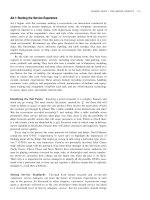Principles of marketing MKTG 8e joe hair carl mcdaniel chapter 012
Bạn đang xem bản rút gọn của tài liệu. Xem và tải ngay bản đầy đủ của tài liệu tại đây (558.01 KB, 39 trang )
Service and
Nonprofit
Organization
Marketing
Chapter 12
Lamb, Hair, McDaniel
2014-2015
© Cengage Learning 2015. All Rights Reserved.
1
Discuss the importance of services to the
economy
2
Discuss the differences between services
and goods
3
Describe the components of service quality
and the gap model of service quality
4
Develop marketing mixes for services
© 2015 by Cengage Learning Inc. All Rights Reserved.
2
5
Discuss relationship marketing in services
6
Explain internal marketing in services
7
Describe nonprofit organizational
marketing
8
Discuss global issues in services
marketing
© 2015 by Cengage Learning Inc. All Rights Reserved.
3
The Importance of Services
Discuss the importance
of services to the
economy
4
1
© 2015 by Cengage Learning Inc. All Rights Reserved.
The Importance of Services
Service industries accounted for
68 percent of U.S. GDP in 2012.
Services involve:
•Deeds
•Performances
•Efforts
1
© 2015 by Cengage Learning Inc. All Rights Reserved.
5
How Services Differ from Goods
Discuss the differences
between services and
goods
6
2
© 2015 by Cengage Learning Inc. All Rights Reserved.
How Services
Differ from Goods
Intangible
Intangible
Inseparable
Inseparable
Heterogeneous
Heterogeneous
Perishable
Perishable
No physical object makes it hard to
communicate benefits.
Production and consumption are
simultaneous, meaning the
consumer takes part in production.
Services depend on their
employees for quality, which
makes consistency difficult to
achieve.
Services cannot be saved, and it is
challenging to synchronize supply
and demand.
2
© 2015 by Cengage Learning Inc. All Rights Reserved.
7
When Services are Assessed
• Search quality: More often applied to
goods, assessed before purchase
• Experience quality: Assessed after
purchase
• Credence quality: Assessed only with
appropriate knowledge.
2
© 2015 by Cengage Learning Inc. All Rights Reserved.
8
Service Quality
Describe the
components
of service quality
and the gap model
of service quality
9
3
© 2015 by Cengage Learning Inc. All Rights Reserved.
Components of Service Quality
Reliability
Reliability
The
The ability
ability to
to perform
perform the
the
service
service right
right the
the first
first time.
time.
Responsiveness
Responsiveness
The
The ability
ability to
to provide
provide
prompt
prompt service.
service.
Assurance
Assurance
The
The knowledge
knowledge and
and courtesy
courtesy
of
of employees.
employees.
Empathy
Empathy
Caring,
Caring, individualized
individualized
attention
attention to
to customers.
customers.
Tangibles
Tangibles
The
The physical
physical evidence
evidence
of
of the
the service.
service.
3
© 2015 by Cengage Learning Inc. All Rights Reserved.
10
Exhibit 12.1
Gap Model of Service Quality
3
11
Marketing Mixes for Services
Develop marketing mixes
for services
12
4
© 2015 by Cengage Learning Inc. All Rights Reserved.
Product Strategies
for Services
Service as a
Process
Core and
Supplementary
Customization/
Standardization
Service
Mix
4
© 2015 by Cengage Learning Inc. All Rights Reserved.
13
Service as a Process
People
People
Processing
Processing
Possession
Possession
Processing
Processing
Mental
MentalStimulus
Stimulus
Processing
Processing
Information
Information
Processing
Processing
4
© 2015 by Cengage Learning Inc. All Rights Reserved.
14
The Service Offering
Core
Core
Service
Service
The
The most
most basic
basic benefit
benefit
the
the
consumer
consumer is
is buying.
buying.
Supplementary
Supplementary
Service
Service
A
A group
group of
of services
services that
that
support
support or
or enhance
enhance the
the
core
core service.
service.
4
© 2015 by Cengage Learning Inc. All Rights Reserved.
15
Customization/Standardization
Mass
Mass
Customization
Customization
A strategy that uses
technology to deliver
customized services
on a mass basis.
4
© 2015 by Cengage Learning Inc. All Rights Reserved.
16
The Service Mix
Determine which new services to introduce
Determine the target market
Decide which existing services to maintain
and which to eliminate
4
© 2015 by Cengage Learning Inc. All Rights Reserved.
17
Place (Distribution) Strategy
Convenience
Convenience
Number
Number of
of outlets
outlets
Direct
Direct or
or indirect
indirect
distribution
distribution
Location
Location
Scheduling
Scheduling
4
© 2015 by Cengage Learning Inc. All Rights Reserved.
18
Promotion Strategy
Stress tangible cues
Use personal information
sources
Create a strong
organizational image
Engage in postpurchase
communication
4
© 2015 by Cengage Learning Inc. All Rights Reserved.
19
Price Strategy
Pricing Challenges for Services
Define the unit of service consumption
Determine if multiple elements are
“bundled” or priced separately
4
© 2015 by Cengage Learning Inc. All Rights Reserved.
20
Pricing Objectives
Revenue-Oriented
Pricing
Maximize the surplus of
income over costs
OperationsOriented
Pricing
Match supply and demand
by varying price
PatronageOriented
Pricing
Maximize the number of
customers by varying price
4
© 2015 by Cengage Learning Inc. All Rights Reserved.
21
Relationship Marketing in Services
Discuss relationship
marketing in services
22
5
© 2015 by Cengage Learning Inc. All Rights Reserved.
Relationship
Marketing in Services
3
Structural
Social
Financial
Creating valueadded services
not available
elsewhere
2
Social
Financial
Design services
to meet
customer needs
1
Financial
Pricing
incentives
5
© 2015 by Cengage Learning Inc. All Rights Reserved.
23
Internal Marketing in Service Firms
Explain internal
marketing in services
24
6
© 2015 by Cengage Learning Inc. All Rights Reserved.
Internal Marketing
Treating employees as
customers and
developing systems and
benefits that satisfy their
needs.
6
© 2015 by Cengage Learning Inc. All Rights Reserved.
25









